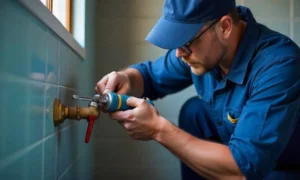Staying updated with the latest technologies is crucial in the realm of plumbing. From enhancing efficiency to minimizing water wastage, advancements in plumbing technologies offer numerous benefits. Over the years, the plumbing industry has witnessed remarkable evolution, with new innovations continually reshaping traditional practices. For plumbers, embracing these cutting-edge technologies is not just about staying competitive; it’s about delivering superior plumbing service and exceeding customer expectations in a rapidly evolving market.
As plumbers in Ottawa and all across the world strive to meet the diverse needs of their clients, staying abreast of new and advanced plumbing technologies becomes paramount. Whether it’s integrating smart water monitoring systems to help homeowners track their water usage or utilizing high-pressure water jetting for efficient drain cleaning, adopting these innovations allows plumbers to offer comprehensive solutions that address modern plumbing challenges effectively. By harnessing the power of technology, plumbers can streamline their operations, improve service quality, and ultimately enhance customer satisfaction.
Smart Water Monitoring Systems
Smart water monitoring systems have emerged as indispensable tools for efficient water management. These systems utilize sensors and data analytics to track water usage in real time. By providing insights into consumption patterns, leaks, and potential issues, smart monitoring systems empower homeowners and businesses to optimize water usage and reduce wastage.
Water-Efficient Fixtures
Water-efficient fixtures, such as low-flow toilets and aerated faucets, are designed to minimize water consumption without compromising performance. These fixtures not only contribute to water conservation but also lead to significant cost savings on utility bills. With advancements in technology, modern water-efficient fixtures offer improved functionality and aesthetics, making them an attractive choice for environmentally conscious consumers.
High-Pressure Water Jetting
High-pressure water jetting is a powerful technique used for cleaning and clearing clogged drains and sewer lines. By utilizing streams of high-pressure water, this method effectively removes debris, grease, and other obstructions without causing damage to pipes. Compared to traditional methods like snaking or chemical cleaning, high-pressure water jetting is more efficient, environmentally friendly, and cost-effective.
Pipe Relining Technology
Pipe relining technology involves repairing damaged or deteriorating pipes by inserting a liner coated with resin into the existing pipe. Once in place, the resin hardens, creating a durable, seamless lining that restores the structural integrity of the pipe. This trenchless repair method eliminates the need for extensive excavation, resulting in minimal disruption to landscaping and reduced labor costs.
Hydrovac Excavation
Hydrovac excavation, also known as hydro excavation or vacuum excavation, utilizes pressurized water and a vacuum system to safely expose underground utilities and structures. In plumbing, hydrovac excavation is commonly used for precision digging around sensitive areas like water mains and sewer lines. This non-destructive method reduces the risk of damage to existing infrastructure and increases efficiency on job sites.
Tankless Water Heaters
Tankless water heaters, also known as on-demand or instant water heaters, heat water directly as it flows through the unit, eliminating the need for a storage tank. This compact and energy-efficient alternative to traditional water heaters provides a continuous supply of hot water, reducing standby energy losses and saving valuable space. With their rapid heating capabilities and long lifespan, tankless water heaters offer convenience and reliability for residential and commercial applications.
UV Disinfection Systems
UV disinfection systems utilize ultraviolet light to destroy bacteria, viruses, and other pathogens present in water. By exposing water to UV radiation, these systems effectively eliminate harmful microorganisms without the use of chemicals, making it a safe and environmentally friendly disinfection method. UV disinfection systems are increasingly being adopted in residential, commercial, and industrial settings to ensure the safety and quality of drinking water.
Pipe Inspection Cameras
Pipe inspection cameras, also known as sewer cameras or drain cameras, are advanced tools used to inspect the interior of pipes and conduits. Equipped with high-resolution cameras and flexible cables, these devices provide real-time visual feedback on the condition of pipes, identifying blockages, leaks, and structural defects. By pinpointing issues with precision, pipe inspection cameras streamline maintenance and repair processes, reducing downtime and costs.
Remote Plumbing Diagnostics
Remote plumbing diagnostics leverage technology to remotely monitor and diagnose plumbing systems in real-time. Through sensors and connectivity solutions, technicians can remotely assess the performance and condition of plumbing equipment, detecting anomalies and potential issues before they escalate. This proactive approach to maintenance improves system reliability, extends equipment lifespan, and minimizes unexpected downtime.
Green Plumbing Practices
Green plumbing practices focus on minimizing environmental impact and promoting sustainability in plumbing systems. From water conservation strategies to energy-efficient designs, green plumbing encompasses a range of eco-friendly solutions aimed at reducing resource consumption and carbon emissions. By implementing green plumbing practices, homeowners and businesses can lower their ecological footprint while enjoying long-term cost savings and regulatory compliance.
Nanotechnology in Plumbing
Nanotechnology holds immense potential for revolutionizing various industries, including plumbing. In plumbing applications, nanomaterials offer enhanced performance, durability, and efficiency. From self-cleaning surfaces to antimicrobial coatings, nanotechnology enables the development of innovative plumbing products that improve hygiene, reduce maintenance requirements, and prolong service life.
Impact of 3D Printing
3D printing technology has opened up new possibilities in plumbing design and manufacturing. With the ability to create complex geometries and custom components, 3D printing allows for rapid prototyping and customization of plumbing fixtures and fittings. From intricate faucet designs to customized pipe connectors, 3D printing is driving innovation in the plumbing industry, offering flexibility, cost-effectiveness, and design freedom.
Integration of IoT in Plumbing Systems
The integration of Internet of Things (IoT) technology in plumbing systems enables remote monitoring, control, and optimization of water management processes. Smart sensors, actuators, and connectivity solutions facilitate data-driven decision-making, predictive maintenance, and automated adjustments to optimize water usage and minimize waste. By harnessing the power of IoT, plumbing systems become smarter, more efficient, and responsive to changing demands.
Conclusion
In conclusion, embracing new and advanced plumbing technologies is essential for modernizing infrastructure, enhancing efficiency, and promoting sustainability. From smart water monitoring systems to IoT-enabled solutions, these innovations offer myriad benefits for homeowners, businesses, and the environment. By staying informed and adopting cutting-edge technologies, we can build resilient plumbing systems that meet the needs of today and tomorrow.



































